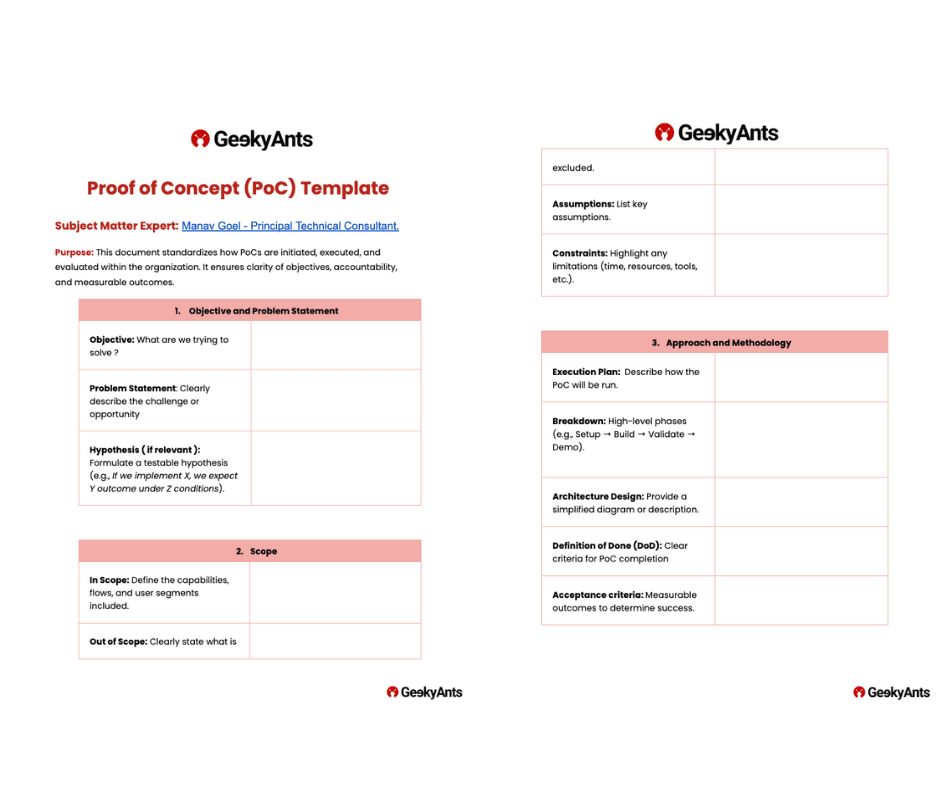Table of Contents
Building a Proof of Concept: A Complete Guide with Implementation Strategies
Author

Subject Matter Expert


Date

Book a call
Key takeaways:
- A Proof of Concept validates feasibility with measurable KPIs, reducing risk before large-scale investment.
- U.S. enterprises gain strategic advantage by embedding compliance and security early in PoC design.
- Reusing validated PoC components accelerates time-to-market and maximizes ROI from innovation.
Every failed project tells the same story: money moves faster than evidence. Theranos. Quibi. Google Stadia. Together, they wiped out billions—not because the technology was impossible, but because no one proved viability before scaling. Dropbox, by contrast, validated its entire idea with a simple three-minute demo.
The lesson is clear: one approach builds first and hopes later; the other tests assumptions upfront. The stakes are especially high in the U.S., where more than 30% of IT projects are cancelled outright, and over 50% struggle with severe overruns or missed targets. Large public-sector programs fare no better—nearly 1 in 5 major projects overshoot budgets by more than 25%, with average planned spends in the hundreds of millions.
What Is a PoC in Software Development?
A Proof of Concept (PoC) in software development is a focused exercise to test whether a proposed solution is technically feasible and capable of delivering business value. It is not a prototype to showcase design, nor an MVP to validate market demand; instead, it establishes whether the underlying idea can be built reliably, integrated with existing systems, and scaled without disproportionate risk.
Why U.S. Companies Should Begin with a PoC Before Scaling
For U.S. technology teams, the cost of building at scale without validation can be staggering. Studies indicate that nearly 70% of large software projects overrun budgets and timelines, often because assumptions were never tested in real-world conditions. A Proof of Concept (PoC) creates a controlled environment to evaluate feasibility, user response, and technical fit before significant resources are committed.
The advantage is not only in reducing risk, it is in building credibility. Investors, compliance officers, and enterprise buyers increasingly expect evidence that a product can deliver as promised. A well-executed PoC helps teams demonstrate value early, win stakeholder confidence, and prioritize features that actually matter to end-users.

Kunal Kumar
COO, GeekyAnts
Key Success Factors for Designing High-Impact PoCs in U.S. Software Development
Effective PoC planning requires precision and foresight. When designed with clear goals and aligned to business realities, a PoC becomes a strategic lever—validating feasibility, reducing uncertainty, and accelerating confident decision-making.
1. Define Clear Validation Goals
2. Prioritise User-Centric Validation
3. Mitigate Risks Early
4. Optimise Resource Allocation
5. Build Stakeholder Confidence
How Do You Build a PoC? A Step-by-Step Development Flow

Manav Goel
PTC, GeekyAnts
Step 1: Define the Problem Statement
Step 2: Establish Quantifiable Success Criteria
- Throughput: sustain 15,000+ API requests/sec under peak loads (e.g., Black Friday).
- Latency: maintain <200 ms at p95, as user drop-off rises beyond this point.
- Reliability: achieve 99.9%+ uptime with resilience under failure.
- Security & Compliance: align with OWASP Top 10, PCI DSS, HIPAA, GDPR.
- Scalability: validate linear performance with auto-scaling.
- Cost Efficiency: compare infra costs (e.g., AWS Lambda vs. containers).
- User Impact: track usability measures like task completion or transaction accuracy.
Step 3: Determine Scope and Resources
Step 4: Build a Controlled Prototype Environment
- Cloud sandbox with monitoring (AWS CloudWatch, Azure Monitor).
- Anonymized, production-scale datasets (e.g., 1M healthcare claims, 100K retail transactions).
- Mock APIs for payments, logistics, or identity providers.
- Enterprise-grade security and access controls, even at PoC stage.
Step 5: Execute Targeted Tests
- Performance & Load: simulate 20K+ concurrent users during peak demand.
- Resilience: chaos tests to validate auto-scaling and redundancy.
- Security: penetration testing and encryption validation.
- Integrations: confirm APIs and third-party systems operate smoothly.
- Regulatory Readiness: run mock audits for HIPAA, PCI DSS, or KYC/AML.
Step 6: Analyze Results and Document Learnings
Step 7: Present Insights and Recommend Next Steps
Download the Proof of Concept Template to Structure and Validate Your Product Strategy
This template provides a clear, structured framework to define validation goals, test technical feasibility, and generate decision-grade evidence for stakeholders—enabling faster, lower-risk product launches.
Turning PoCs into Enterprise-Ready Solutions: Best Practices for Compliance, Cost Efficiency, and Growth
A PoC delivers maximum value only when its outcomes are systematically embedded into enterprise processes. For U.S. organizations, where software projects operate under tight compliance standards and competitive pressure, implementation is as critical as design. The following best practices ensure PoCs transition seamlessly into full-scale products and deliver measurable ROI.
1. Align PoC with Agile Delivery Models
2. Integrate Outcomes into Product Architecture
3. Embed Compliance Early
4. Translate Technical Findings into ROI Metrics
5. Establish Knowledge Reuse Frameworks

Kunal Kumar
COO, GeekyAnts
Choosing the Right Validation Tool: PoC vs Prototype vs MVP
In product development, the cost of selecting the wrong validation tool is time, money, and market opportunity. A Proof of Concept (PoC) is proof of feasibility, a Prototype proof of user interaction, and a Minimum Viable Product (MVP) proof of market acceptance. Comparison between all these is shown in the table below to better enable enterprises to decide which is best for what stage of innovation.
| Parameter | Proof of Concept (PoC) | Prototype | Minimum Viable Product (MVP) |
|---|---|---|---|
| Core Objective | Validate technical feasibility and solution viability | Demonstrate design, usability, and interaction | Launch core functionality to test market demand |
| Primary Audience | Internal teams, technical leads, stakeholders | Design teams, early reviewers, investors | Early adopters, real users, and investors |
| Outcome Delivered | Functioning core, may lack UI or polish | Clickable or visual mockup simulating UX | Functional product with limited but usable features |
| Cost & Timeframe | Low–moderate; typically days to weeks | Moderate; weeks for high-fidelity versions | Higher; development and launch may take months |
| Primary Risk Addressed | Technical viability and integration risks | Usability, user flow, and interface issues | Market demand and business value assumptions |
| Typical Use | Very early stage when feasibility is uncertain | Pre-development phase for design validation | Post-feasibility and design validation; market test |
Cost and Timeline Benchmarks for U.S. Enterprises
Software validation stages in the U.S. are shaped by high labor costs, compliance requirements, and accelerated go-to-market expectations. Unlike global averages, U.S. app development budgets reflect premium engineering talent, rigorous audit standards, and enterprise-scale demands. The table below outlines indicative cost and timeline ranges for PoCs, Prototypes, and MVPs based on typical U.S. conditions. These serve as directional benchmarks and should be refined with SME input for industry-specific accuracy.
| Stage | Goal | Cost (U.S.) | Timeline (U.S.) | Compliance Considerations |
|---|---|---|---|---|
| PoC | Validate feasibility and reduce technical risk | $25K – $60K | 3 – 6 weeks | Early HIPAA/PCI/GDPR checks, light security |
| Prototype | Demonstrate usability and design flow | $40K – $100K | 4 – 8 weeks | Accessibility, early security patterns |
| MVP | Test adoption with core functionality | $120K – $300K+ | 3 – 6 months | Full compliance (HIPAA, PCI DSS, SOC2) |

Even well-intentioned Proof of Concepts often fail to deliver decision-grade clarity. The issue is rarely technical capability—it is how teams design, scope, and execute PoCs. For U.S. enterprises, where budgets and compliance stakes are high, avoiding these pitfalls is critical.
1. Overloading the Scope
2. Ignoring Compliance Early
3. Treating PoC as a Throwaway
4. Lack of Quantifiable Success Metrics
5. Underestimating Resource Needs
6. Poor Stakeholder Alignment
Hiring Models and Engagement Modes for Successful PoC Development
Selecting the right hiring model for PoC execution is often as critical as the technology itself. In the U.S., where costs are high and speed-to-market is vital, enterprises must balance expertise, delivery time, and financial efficiency. The three dominant models are In-house teams, Freelancers, and Outsourcing partners—each with distinct trade-offs.
| Model | Strengths | Limitations | Best Fit |
|---|---|---|---|
| In-House Teams | Full control, organizational alignment, direct collaboration. | High fixed costs (salaries, benefits), slower ramp-up, limited PoC exposure. | Large enterprises with long-term innovation roadmaps and existing tech teams. |
| Freelancers | Low upfront cost, flexible contracts, quick availability. | Variable quality, limited accountability, unsuitable for compliance-heavy PoCs. | Early-stage ideas, small experiments, or non-critical prototypes. |
| Outsourcing Partners (e.g., GeekyAnts) | Balanced quality, cost, and speed. Access to specialized teams, proven frameworks, and regulatory expertise. | Requires strong governance and clear communication. | U.S. enterprises seeking rapid, compliant, and scalable PoC delivery |
Enterprise-Grade Proof of Concept Examples That Made an Impact
roof of Concepts are most valuable when they reveal whether an idea can succeed under real-world conditions. Below are examples that illustrate how PoCs de-risk innovation and accelerate decision-making for enterprises.
1. Netflix: Scaling for Global Streaming
2. PayPal: Payment Security Enhancements
3. Tesla: Over-the-Air (OTA) Updates
4. Healthcare Startups (U.S. HIPAA Context)
Why Partner with GeekyAnts for U.S. and Global PoC Development

Kunal Kumar
COO , GeekyAnts
Expertise Across Domains
- Fintech: Digital wallets, payment gateways, fraud detection, compliance with PCI DSS.
- Healthcare: HIPAA-compliant telemedicine platforms, claims automation, and secure health data flows.
- Retail & eCommerce: Scalable PoCs for high-traffic U.S. retail events such as Black Friday, integrating AI-driven personalization.
- Emerging Tech: Blockchain for supply chains, IoT ecosystems for predictive maintenance, and AR/VR experiences to improve customer engagement.
Conclusion
For U.S. enterprises, a Proof of Concept serves as the safeguard between vision and execution. With rising software spend and strict compliance demands, leaders need clarity backed by evidence, not assumptions. The most effective PoCs focus sharply on the riskiest assumptions, quantify outcomes with hard metrics, and reuse validated components to accelerate time-to-market. Companies that embed this discipline into their innovation process build a repeatable framework for scaling ideas with confidence and creating measurable impact.
Dive deep into our research and insights. In our articles and blogs, we explore topics on design, how it relates to development, and impact of various trends to businesses.


